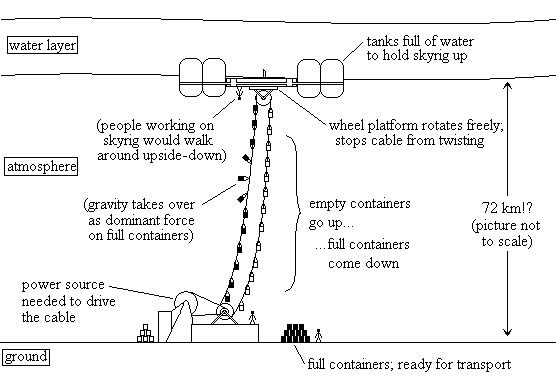Thank you Cephron!
I like your questions very much.
cephron wrote:
3.
Quote:
It does not fill the atmosphere as vapor, but is in a different form, which is invisible.
Slightly confusing way of putting it, but I think I know what you mean. "Vapor" is a rather...cloudy term, if you'll pardon the pun.

Water vapor (in the scientific sense) is always invisible. What we see in mist/steam/clouds is tiny, suspended droplets of liquid water that have condensed out of the vapor...but these condensed droplets are often also referred to as vapor, themselves. Do you mean to say that water fills the atmosphere as a gaseous vapor (invisible) but never condenses into visible droplets on its own? That would seem to square with the bits below...
Only slightly confusing? That is an improvement. My main problem is the confusion I generate when I try to describe what comes into my mind. What comes into my mouth is so inferior to what comes into my mind.
Actually any vapor below the canopy is forced up into it. No condensation takes place except in laboratories. The water that is forced out of the canopy into the air below is not in a vapor, though it is invisible. It is in a form not known to us, and only plants in those planets have the processes for transforming it back into its known form. I need to make a name for the other form. All I can think of calling it for now is heshot transformed water.
cephron wrote:
It seems clear that there is some relationship between heshot radiation and water's ability to condense.
There is, but it is only that water vapor is forced into the canopy rather than being allowed to condense. Bodies of water can be gathered from plants, but are lost as they evaporate unless their evaporation is contained, so that the vapor cannot reach the canopy.
cephron wrote:
I like this a lot; you seem to have thought out some implications for a radiation that penetrates matter without losing intensity, though it changes in quality. This heshot radiation is neat stuff! What kinds are there, and what interactions do they have, with water and everything else? Would love to see this system fleshed out in a consistent way (I imagine that would be something of a challenge!).
There is only a certain kind of radiation on cone-sunned Earths, and it has very many different effects. There is not only heshot radiations though, but heshot shapes: new shapes; new numbers, new substances and new physical laws, and for now I am only describing the effect of a certain kind of heshot radiations on non-heshot things.
cephron wrote:
Hmmm...how do you get the climate variation? You've actually eliminated the two biggest contributors to climate variation, namely difference in temperature and availability of water. Is it about nutrients in the soil/ground? Is there something hostile (chemically or otherwise) that prevents growth in the deserts?
This is one of the most interesting things, something I have developed mostly after I read your question. I already knew that something resembling electricity, going from the ground into the air, was a significant part of the weather. Recently it occurred to me that the deserts were probably of electric origin. Then I realized the process. The weather on those planets is very haunting, very... disturbing.
Sounds, possibly with heshot parts, and not many of them within the range of human hearing, run through the earth, possibly originating from what ever causes the earthquake grounds, converge in certain places, breaking something you could call a "concentration barrier," and generating "electric" fires. There would have been no deserts in the original planets, as you would expect.
These fires would be smokeless, of course, because of the "aerosol suppression." They form very little tongues, most of the time none at all, the fire would be spherical, covering things like a coating of ice or dew. When the desert is burned out, there rise from the ground great arcs of "electricity" in rows, or single arcs like solar flares. These "electric eruptions" would be the weather, or storms, of the deserts, other than dust storms. Often the arcs would have faint concentric arcs within and without the main arc, like a multiplied rainbow. Sometimes the rows of arcs would branch along "sound fault lines." There would also be arcs that form in the air and constrict down into the ground. Sometimes there would be a short dense row of static, incomplete arcs, which would look like tufts of lightening quivering in the air. There would be other phenomena like ghost lights, ball lightening, lights like fire flies.
In a few words, the deserts are eldritch places to be.
cephron wrote:
But liquefied earth? What is it, sand ground to dust so fine that it flows like a viscous liquid?
Here is a link about it:
http://en.wikipedia.org/wiki/Soil_liquefactioncephron wrote:
Can plants photosynthesize underground? Can heshot radiation pass through one plant and still be used by another?
It can certainly pass through one plant and be used by another, I mention that in one of the other threads. I actually did not think of plants underground (though I might have in time, I have developed other underground plants). It is a good point, caves in gas-sunned Earths are dark, and do not have green plants, but in cone-sunned Earths they would be in perpetual "night light." I believe that something would be very different about underground plants and plants in the lower layers of forest.
cephron wrote:
You seem to have a larger proportion on flying creatures...can they fly up and drink directly from the water canopy? If so, that might explain a prevalence relative to land-bound creatures, which seem dependant on eating plants to get their water. Btw, does anything live in the canopy itself?
I had not thought of that, and it makes perfect sense. Thank you for your observativeness!
Of course there would be sea life in the canopy itself, necessarily of a different kind because of the strange situation, but I had not given it enough thought. Amita4ever thought of the idea of bio-luminescent algae. It may be that the sky is clouded by the life in the canopy (which would be very indistinct in the high atmosphere) rather than by clouds of water.
But there is the problem of anything that is not water staying in the canopy. Anything light or buoyant enough not to fall (whatever suspends the water would not suspend fish) would float on the lower surface of the canopy. Though they would be able to use the currents the same way they would use prevailing winds, and perhaps feed on algae very near the lower surface, I do not know what else could be done.
Yes I do though! If the creature had enough water in its makeup the weight of the rest of the creature would not be able to draw the water it was attached to out of the canopy. In fact if you drove a tank truck to the top of a mountain (which would be impossible because they are too high and steep) the entire truck would rise into the air like a balloon, gathering speed, eventually crashing into the canopy and the broken wreckage would rain out of the upper atmosphere like meteorites.
cephron wrote:
I read a little about the thorn-sunned earths, but I couldn't view the scifi forum stuff. I should get an account there.
I just posted the development from the other threads in the thread on the Fantasy forum, but you still need to get an account on the Sci-fi side! From the posts you have posted here I can tell that your good thinking is needed there.
Here is development I have posted in the other threads (at least one of your other questions is answered here):
Quote:
Bright and heat do not always go hand in hand (though as far as I know they always go hand in hand when it comes to Familiarworld stars), there are creatures that chemically produce light without any heat at all. Cone-suns actually give off about the same amount of heat as gaseous round-suns such as ours. I do not know whether it gives off a little less heat than our sun, or if the planet has a slightly wider orbit. The canopy does not effect the amount of heat (though it may change it slightly, as the light is changed when it passes through something) scientists who experimented with the idea of a water canopy on earth found that even a thin canopy would increase the earths temperature greatly. Think of Venus.
But I believe that the water canopy does not act the way it would on earth because everything on cone-sunned Earths is changed by the heshot radiations. The heat may actually pass through everything the way the light does.
One of the many things I did not go into detail about is that the light passes through the entire planet and shines out of the ground at night. Of course it is completely different, though no less. It is especially different at the point of the earth opposite the sun.
There are many ways I could describe the changes in light when it passes through something. It is not like prismatic scattering at all (unless, of course, the light passed through a prism). It is like a new color, not a new color hue, but a new primary color, or a new kind of white (the light of a cone-sun or thorn-sun is a little whiter than other suns). You could also say that the light resonates differently, that the light has a deeper pitch, or a higher pitch. Things become very complicated to describe when the heshot spectrum is involved.
But I can say simply that no where on a cone-sunned Earth will you see dark.
Anyway, I really like the idea of the clouds of bio-luminescent algae. The stars would be visible to the people who live on those planets, though not in the sense that we would think. The atmosphere is transparent so that the stars are equally visible in day and night (like the thorn-sunned Earths, see their thread), but the stars would not be seen in a black sky as they would be in thorn-sunned Earths, because in cone-sunned Earths the atmosphere seems to be made of light (you cannot see dark anywhere). You could hardly describe it as seeing the stars, it is more like detecting them. So inhabitants of cone-sunned Earths would be able to "see" the stars more clearly than people of other types of Earths, and at any time of day or night.
Even the people who live in cone-sunned Earths cannot look straight at the sun even nearly, except for a very few who train themselves to do it.
~
Amita4ever wrote:
if I had some really good sun glasses - LOL!

Exactly. Dark glasses, lussil, feature in many situations.
Amita4ever wrote:
What causes the sun to take this unusual shape?
I should point out that the cone-sun is solid, rather than gaseous. Only certain round-suns are gaseous, like our sun. The rest are solid, and are called patar. Have you seen the introduction thread in the Iniel world sub-forum? I mention the suns:
http://www.holyworlds.org/scifi/viewtop ... f=66&t=981I believe that the shape of the sun effects the sort of heshot radiations, but I do not know exactly how. It is almost like inventing nuclear fusion by yourself.
One thing that I forgot to mention in the last post was that because the light shines through the moon, the moon is always full.
~
Something more about cone-sunned Earths:
Quote:
and great tracts of land so densely grown with plants that they are uninhabitable.
These regions are rarely like the dense forests we know. The forests on cone-sunned Earths are often solid plant material, and it is not only the outside layers that can be green, since the light penetrates every layer. Some of the plants grow as hard and as sharp as metal. It is in these forests that the vast flocks of birds and varieties of insects nest.
Varon wrote:
Wow. These are fascinating.
Can the flash-marks change an organism's genetic structure?
Thank you Varon!
And I at last remembered your question!
I like the idea. But I think it would be more likely to change the actual physical and chemical properties of any organism caught in the flash as it happened. When I thought of the flash marks I thought some of them would look like the pictures in this link:
http://en.wikipedia.org/wiki/Vernal_poolsBut there would also be other kinds.
I believe that things like tektites would form in them also, this is a link about tektites:
http://en.wikipedia.org/wiki/TektitesOf course the flash marks can vary in size, and they vary from about the size of a coin to the size of a small lake. There are also partial flash marks were the canopy only becomes dangerously thin, without actually opening. These partial flash marks are not permanent like the full flash marks though.
Whew indeed. The reply was even less brief. It was fun though. It even raised sweat at one point.



